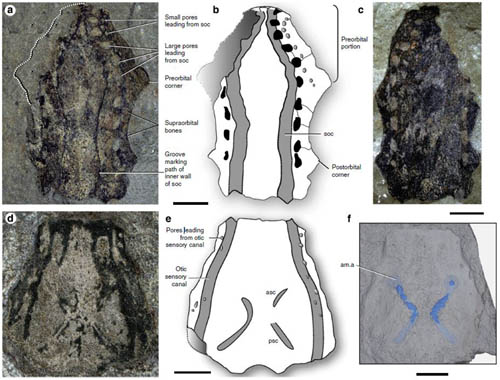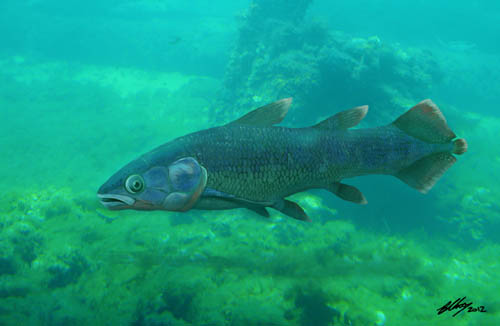New Finding Extends the Range of Anatomically Modern Coelacanths to the Early Devonian
Among sarcopterygians (lobe-finned fishes and tetrapods), coelacanths are known for their evolutionary conservatism. Epitomized by the legendary living fossil Latimeria, the distinctive body plan of anatomically modern coelacanths can be traced back to fossil forms from the late Middle Devonian. However, the group’s early history is unclear because of an incomplete fossil record. In a study published April10 in the journal of Nature Communications, Dr. ZHU Min, Institute of Vertebrate Paleontology and Paleoanthropology (IVPP), Chinese Academy of Sciences, and his collaborators reported the earliest known coelacanth skull (Euporosteus yunnanensis sp. nov.) from the Early Devonian (late Pragian) of Yunnan, China, which represents the first record of an anatomically modern coelacanth before the late Middle Devonian. The new form extends the chronological range of the anatomically modern coelacanths by about 17million years, and adds to the growing body of evidence pointing to the South China block as the centre for sarcopterygian diversification, from which coelacanth representatives were peculiarly absent until now.
The new materials, consisting of a parietonasal shield and a postparietal shield, were collected in 2009 and 2011 from a yellow sandstone layer of the Posongchong Formation, near Qingmen Reservoir, Zhaotong, Yunnan, China. In addition to invertebrate lingulids and plants, associated vertebrate faunal members include galeaspid agnathans, placoderms, onychodonts and rhipidistians. The late Pragian age of the Posongchong Formation is mainly based on the correlation of marine invertebrates and conodonts from the overlying Pojiao Formation. Associated plant megafossils (the Posongchong Flora) display obvious endemism, but some cosmopolitan members are shared by the Posongchong Flora and the coeval upper Baragwanathia flora in Australia.
An important question for studying patterns of the coelacanth evolution is when the anatomically modern coelacanths developed their distinctive body plan. The early fossil record of coelacanths has been scarce, and opinions differ on which sarcopterygian taxon is the closest sister group of coelacanths.
So far, the earliest record of the traditionally defined coelacanth group is one isolated dentary (Eoactinistia) from the Early Devonian (late Pragian, about 409 million years ago) of Australia. “Because of its limited morphological features, Eoactinistia cannot be subjected to a phylogenetic analysis and its position within the coelacanths is unknown”, said study coauthor Xiaobo Yu, professor of Department of Biological Sciences, Kean University, New Jersey, USA.
Contrary to all expectations for such an early form, Eoactinistia possesses the large dentary sensory pore present in coelacanths from the Carboniferous and younger age, but absent from any of the Middle–Late Devonian forms. The presence of the dentary pore raises the tantalizing possibility that Eoactinistia may be an anatomically modern coelacanth, previously known only from the late Middle Devonian and younger age. “However, the unknown phylogenetic position of Eoactinistia and the lack of any other Early Devonian coelacanth fossils make it impossible to weigh this possibility against other possibilities, that is, the dentary pore as an independently derived feature that arose twice among coelacanths, or as a primitive feature that was lost in other Devonian forms but then reappeared in later coelacanths”, said ZHU Min, lead author and project designer.
“The new material resembles Euporosteus eifeliensis from the Middle Devonian of Germany and reveals unique features to justify the erection of a new species. Phylogenetic analysis places the new form (together with Euporosteus eifeliensis ) crownward of Diplocercides or as its sister taxon. The finding expands the existing knowledge of Euporosteus, and represents the first record of an anatomically modern coelacanth before the late Middle Devonian”, said ZHU Min, “It lends support to the possibility that the dentary pore of Eoactinistia may be a synapomorphy indicating its membership among the anatomically modern coelacanths, previously known only from the late Middle Devonian and younger age”.
Many studies have pointed out that coelacanths went through a period of rapid early diversification, but have since displayed remarkable morphological stasis over extended geological time. “A recent study of the HOX clusters of the Indonesian coelacanth Latimeria menadoensis found features indicating stasis in genome evolution that may be correlated with the stasis in morphological evolution”, said Xiaobo Yu, “This finding provides a more refined reference point for studying the rapid early diversification and subsequent evolutionary conservatism of the coelacanths”.
This research is supported by grants from the Chinese Academy of Sciences, the Major Basic Research Projects of MST of China, the National Nature Science Foundation of China and the CAS/SAFEA International Partnership Program for Creative Research Teams. 
Fig.1: Euporosteus yunnanensis sp. nov. from the Early Devonian. (a–c) Holotype, IVPP V17682.1, a parietonasal shield: (a) Internal mould, (b) Interpretative drawing, (c) External mould. (d–f) IVPP V17682.2, a postparietal shield in dorsal view, with dermal bones largely eroded: (d) Photo, (e) Interpretative drawing, (f) Computer reconstruction of micro-CT scanning data showing the outline of the semicircular canals by transparency mode. (Images by ZHU Min) 
Fig.2: Reconstruction of Euporosteus yunnanensis. (Image by Brian Choo)
Download attachments: